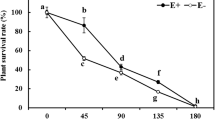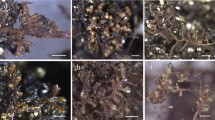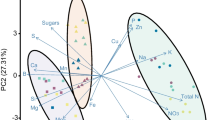Abstract
The symbiotic Epichloë festucae var. lolii endophyte produces alkaloids which can provide its host grass, perennial ryegrass (Lolium perenne L), with a selective advantage in both natural and agricultural managed ecosystems. This study focuses on understanding the alkaloid concentrations that occur in endophyte-infected perennial ryegrass during the early establishment phase. In a glasshouse experiment fungal alkaloid concentrations (peramine, lolitrem B, ergovaline, and epoxy-janthitrems) were measured in perennial ryegrass seedlings infected with E. festucae var. lolii proprietary strains AR1, AR37, NEA2, and NZ common toxic for 69 days after sowing. The endophyte becomes metabolically active, starting alkaloid production, as early as 6 days after sowing. Alkaloid concentrations peaked in 8- to 10- day-old seedlings due to a seedling growth slowdown. This study provides data showing that the loss of insect protection in endophyte-infected seedlings is linked to a reduction in chemical defence after seed-stored, maternally synthesised alkaloids are diluted by seedling dry matter accumulation.









Similar content being viewed by others
Change history
27 March 2020
The original version of this article unfortunately contained a mistake. There is a mistake in the affiliation section and Figure 6. The correct affiliation and Figure 6 are shown here.
References
Anslow R (1962) A quantitative analysis of germination and early seedling growth in perennial ryegrass. Grass Forage Sci 17:260–263
Arechavaleta M, Bacon CW, Plattner RD, Hoveland CS, Radcliffe DE (1992) Accumulation of ergopeptide alkaloids in symbiotic tall fescue grown under deficits of soil water and nitrogen fertilizer. Applied and Environmental Microbiology 58:857–861
Bacon CW, Siegel MR (1988) Endophyte parasitism of tall fescue. Journal of Production Agriculture 1:45–55
Ball OJ-P, Prestidge RA, Sprosen JM (1993) Effect of plant age and endophyte viability on peramine and lolitrem B concentration in perennial ryegrass seedlings. In: Hume DE, Latch GCM, Easton HS (eds) Proceedings of the 2nd international symposium on Acremonium/grass interactions, vol 2. Palmerston North, New Zealand, pp 63–66
Ball OJP, Barker GM, Prestidge RA, Lauren DR (1997a) Distribution and accumulation of the alkaloid peramine in Neotyphodium lolii-infected perennial ryegrass. Journal of Chemical Ecology 23:1419–1434
Ball OJP, Barker GM, Prestidge RA, Sprosen JM (1997b) Distribution and accumulation of the mycotoxin lolitrem B in Neotyphodium lolii-infected perennial ryegrass. Journal of Chemical Ecology 23:1435–1449
Ball OJP, Christensen MJ, Prestidge RA (1994) Effect of selected isolates of Acremonium endophyte on adult black beetle (Heteronychus arator) feeding. In: Popay A (ed) Proceedings of the 47th New Zealand plant protection conference, New Zealand Plant Protection Society, 9–11 august, vol 47. Rotorua, New Zealand, pp 227–231
Bluett SJ, Thom ER, Clark DA, Macdonald KA, Minnee EMK (2005a) Effects of perennial ryegrass infected with either AR1 or wild endophyte on dairy production in the Waikato. New Zealand journal of agricultural research 48:197–212
Bluett SJ, Thom ER, Clark DA, Waugh CD (2005b) Effects of a novel ryegrass endophyte on pasture production, dairy cow milk production and calf liveweight gain. Collingwood, Australia
Bultman TL, Bell GD (2003) Interaction between fungal endophytes and environmental stressors influences plant resistance to insects. Oikos 103:182–190. https://doi.org/10.1034/j.1600-0706.2003.11574.x
Bultman TL, McNeill M, Krueger K, de Nicolo G, Popay AJ, Hume DE, Mace WJ, Fletcher LR, Koh YM, Sullivan TJ (2018) Complex interactions among sheep, insects, grass, and fungi in a simple New Zealand grazing system. J Chem Ecol 44:957–964
Card SD, Faville MJ, Simpson WR, Johnson RD, Voisey CR, De Bonth ACM, Hume DE (2014) Mutualistic fungal endophytes in the Triticeae – survey and description microbial ecology
Christensen M, Voisey C (2007) The biology of the endophyte/grass partnership. In: Popay a, Thom ER (eds) 6th international symposium on fungal Endophytes of grasses, vol grassland research and practice series no. 13. New Zealand grasslands association, Christchurch, New Zealand, pp 123-133
Christensen MJ et al (2008) Epichloë endophytes grow by intercalary hyphal extension in elongating grass leaves. Fungal Genet Biol 45:84–93
Christensen MJ, Bennett RJ, Schmid J (2002) Growth of Epichloe/Neotyphodium and p-endophytes in leaves of Lolium and Festuca grasses. Mycological Research 106:93–106
Clay K (1988) Fungal endophytes of grasses: a defensive mutualism between plants and fungi Ecology:10–16
di Menna ME, Mortimer PH, Prestidge RA, Hawkes AD, Sprosen JM (1992) Lolitrem B concentrations, counts of Acremonium lolii hyphae, and the incidence of ryegrass staggers in lambs on plots of A. lolii-infected perennial ryegrass. New Zealand journal of agricultural research 35:211–217
Faeth SH, Bush LP, Sullivan TJ (2002) Peramine alkaloid variation in Neotyphodium-infected Arizona fescue: Effects of endophyte and host genotype and environment. Journal of Chemical Ecology 28:1511–1526
Faville M, Koulman A, Briggs L, Cao M, Podmore C (2007) Abraham D Exploring endophyte compatibility in perennial ryegrass. In: Proceedings of the 6th International Symposium on Fungal Endophytes of Grasses’. Christchurch, New Zealand. Grassland Research and Practice Series 13:143–146
Fuchs B, Krischke M, Mueller MJ, Krauss J (2013) Peramine and lolitrem B from endophyte-grass associations cascade up the food chain. Journal of chemical ecology 39:1385–1389
Glassey C, Roach C, Strahan M, McLean N (2010) Dry matter yield, pasture quality and profit on two Waikato dairy farms after pasture renewal. In: Proceedings of the New Zealand Grassland Association, 72. pp 91–96
Guerre P (2015) Ergot alkaloids produced by endophytic fungi of the genus. Epichloë toxins 7:773–790
Gundel PE et al (2018) Occurrence of alkaloids in grass seeds symbiotic with vertically-transmitted Epichloë fungal endophytes and its relationship with antioxidants. Frontiers in Ecology and Evolution 6:211
Hennessy LM, Popay AJ, Finch SC, Clearwater MJ, Cave VM (2016) Temperature and Plant Genotype Alter Alkaloid Concentrations in Ryegrass Infected with an Epichloë Endophyte and This Affects an Insect Herbivore Frontiers in Plant Science 7
Johnson LJ et al. (2013) The exploitation of epichloae endophytes for agricultural benefit fungal diversity 60:171-188 doi:https://doi.org/10.1007/s13225-013-0239-4
Knoch TR, Faeth SH, Arnott DL (1993) Endophytic fungi alter foraging and dispersal by desert seed-harvesting ants. Oecologia 95:470–473. https://doi.org/10.1007/bf00317429
Leuchtmann A, Bacon CW, Schardl CL, White JFJ, Tadych M (2014) Nomenclatural realignment of Neotyphodium species with genus Epichloë. Mycologia:106. https://doi.org/10.3852/13-251
Lucero JE, Callaway RM (2018) Granivory from native rodents and competition from an exotic invader strongly and equally limit the establishment of native grasses. Oecologia 186:1043–1053
Madej CW, Clay K (1991) Avian seed preference and weight loss experiments: the effect of fungal endophyte-infected tall fescue seeds. Oecologia 88:296–302
Mitchell ML, Virgona J, Jacobs JL, Kemp D (2014) Population biology of Microlaena stipoides in a south-eastern Australian pasture. Crop and Pasture Science 65:767–779
Moate PJ et al (2012) Effects of wild-type, AR1 and AR37 endophyte-infected perennial ryegrass on dairy production in Victoria. Australia Animal Production Science 52:1117–1130. https://doi.org/10.1071/AN12126
Moore JR, Pratley J, Mace W, Weston LA (2015) Variation in alkaloid production from genetically diverse Lolium accessions infected with Epichloë species journal of agricultural and food chemistry
Popay A, Marshall S, Baltus J (2000a) Endophyte infection influences disappearance of perennial ryegrass seed. In: Zydenbos SM (ed) New Zealand plant protection, 7–10 August, vol 53. Christchurch, New Zealand, pp 398–405
Popay AJ, Baltus J, Pennell C (2000b) Insect resistance in perennial ryegrass infected with toxin-free Neotyphodium endophytes. In: fourth international Neotyphodium/grass interactions symposium, Soest, Germany, pp 187–193
Popay AJ, Bonos SA (2005) Biotic responses in Endophytic grasses. In: Roberts CA, West CP, Spiers DE (eds) Neotyphodium in cool-season grasses. Blackwell Publishing, Ames, pp 163–185
Popay AJ, Hume DE (2011) Endophytes improve ryegrass persistence by controlling insects. In: Mercer CF (ed) Pasture persistence symposium. Grassland research and practice series no. 15, vol 15. New Zealand Grassland Association, Dunedin, pp 149–156
Popay AJ, Wyatt RT (1995) Resistance to argentine stem weevil in perennial ryegrass infected with endophytes producing different alkaloids. In: Popay a (ed) New Zealand plant protection conference, vol 48. 8-10 august, Hastings, pp 229-236
Qawasmeh A (2012) Biochemical consequences of endophytic fungi–grass mutualism. Charles Sturt University
Rasmussen S, Lane GA, Mace W, Parsons AJ, Fraser K, Xue H (2012) The use of genomics and metabolomics methods to quantify fungal endosymbionts and alkaloids in grasses. Methods in Molecular Biology 860:213–226
Rasmussen S et al (2006) High nitrogen supply and carbohydrate content reduce fungal endophyte and alkaloid concentration in Lolium perenne. New Phytol 173:787–797
Rowan DD, Dymock JJ, Brimble MA (1990) Effect of fungal metabolite peramine and analogs on feeding and development of Argentine stem weevil (Listronotus bonariensis). Journal of Chemical Ecology 16:1683–1695
Ruppert KG, Matthew C, McKenzie CM, Popay AJ (2017) Impact of Epichloë endophytes on adult Argentine stem weevil damage to perennial ryegrass seedlings. Entomologia Experimentalis et Applicata 163:328–337
Ryan G, Rasmussen S, Parsons A, Newman J (2015) The effects of carbohydrate supply and host genetic background on Epichloë endophyte and alkaloid concentrations in perennial ryegrass. Fungal Ecology 18:115–125
Schardl CL, Leuchtmann A, Chung KR, Penny D, Siegel MR (1997) Coevolution by common descent of fungal symbionts (Epichloë spp.) and grass hosts. Mol Biol Evol 14:133–143
Simpson WR, Schmid J, Singh J, Faville MJ, Johnson RD (2012) A morphological change in the fungal symbiont Neotyphodium lolii induces dwarfing in its host plant Lolium perenne. Fungal Biology 116:234–240. https://doi.org/10.1016/j.funbio.2011.11.006
Spiering MJ, Lane GA, Christensen MJ, Schmid J (2005) Distribution of the fungal endophyte Neotyphodium lolii is not a major determinant of the distribution of fungal alkaloids in Lolium perenne plants. Phytochemistry 66:195–202. https://doi.org/10.1016/j.phytochem.2004.11.021
Steinfeld H, Gerber P, Wassenaar T, Castel V, Rosales M, Rosales M, de Haan C (2006) Livestock's long shadow: environmental issues and options. Food & Agriculture Org.,
Stewart AV (1985) Perennial ryegrass seedling resistance to argentine stem weevil. N Z J Agric Res 28:403–407
Sugawara K, Ohkubo H, Tsukiboshi T (2007) Distribution and morphology of Neotyphodium endophytes in apical meristems of host plants as observed using differential interference contrast microscopy. In: Proceedings of the 6th International Symposium on Fungal Endophytes of Grasses, pp 139–141
Tan YY, Spiering MJ, Scott V, Lane GA, Christensen MJ, Schmid J (2001) In planta regulation of extension of an endophytic fungus and maintenance of high metabolic rates in its mycelium in the absence of apical extension. Applied and Environmental Microbiology 67:5377–5383
VSN International (2018) GenStat for windows 18th edition. VSN International, Hempel Hempstread, UK
Wang J et al. (2014) Development and implementation of a multiplexed single nucleotide polymorphism genotyping tool for differentiation of ryegrass species and cultivars molecular breeding 33:435-451
Zhang W, Card SD, Mace WJ, Christensen MJ, McGill CR, Matthew C (2017) Defining the pathways of symbiotic Epichloë colonization in grass embryos with confocal microscopy. Mycologia 109:153–161
Zhang W, Mace WJ, Matthew C, Card SD (2019) The impact of endophyte infection, seed aging and imbibition on selected sugar metabolite concentrations in seed journal of agricultural and food chemistry
Acknowledgements
The authors would like to thank New Zealand Agriseeds and Alan Stewart from PGG Wrightson Seeds for providing seed material. Special gratitude goes to the T.R. Ellett Agricultural Research Trust for funding.
Author information
Authors and Affiliations
Contributions
KGH, WJM, AJP, CMcK, CM conceived and designed the research. KGH conducted the experiment as part of her Master of Science (Research). CMcK analysed the data. KGH wrote the majority of the manuscript. All authors read and approved the manuscript.
Corresponding author
Additional information
The original version of this article was revised: The original version of this article unfortunately contained a mistake. There is a mistake in the affiliation section and Figure 6. The correct affiliation and Figure 6 are shown here.
Rights and permissions
About this article
Cite this article
Hewitt, K.G., Mace, W.J., McKenzie, C.M. et al. Fungal Alkaloid Occurrence in Endophyte-Infected Perennial Ryegrass during Seedling Establishment. J Chem Ecol 46, 410–421 (2020). https://doi.org/10.1007/s10886-020-01162-w
Received:
Revised:
Accepted:
Published:
Issue Date:
DOI: https://doi.org/10.1007/s10886-020-01162-w




